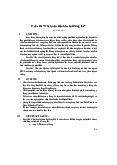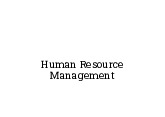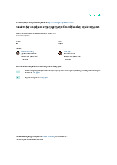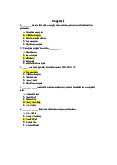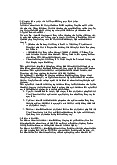



















Preview text:
HRM 22.2A FINAL EXAM REVISION
Exam structure (Time: 90 minutes (closed book)
1. 28 multiple choice questions (7 marks);
2. One theory question (1 mark);
3. One case analysis (2 marks);
Chapter 1 Managing Human Resource Today • What is HR Management
The process of acquiring, training, appraising, and compensating employees,
attending to their labor relations, health and safety, and fairness concerns.
Chapter 4 Job Analysis and Talent Management • The basis of Job Analysis
The procedure for determining the duties and skil requirements of a job and th
of person who should be hired for it.
Job analysis produces information for writing job descriptions and job specifica
JOB DESCRIPTIONS: List of a job’s duties, responsibilities, reporting
relationships, working conditions, and supervisory responsibilities
JOB SPECIFICATIONS: List of a job’s “human requirements,” that is, the requisite
education, skil s, personality, and so on—another product of job analysis.
• Method of Col ecting Job Analysis information
Interview (Individual, Group and Supervisor) Questionnaires Observation Participant Diary/Log
Electronic Job Analysis Methods
• Writing Job Descriptions & Job Specifications Job Descriptions Job Specifications - Most important product of a - The job specification take job analysis. the job description and - A written statement of wha answers the question, the worker does, how he o - “What human traits and she does it, and what the job experience are required to d working conditions are. this job effectively?” - No standard format.
Chapter 5 Personal Planning and Recruiting
• Workforce planning & forecasting/ forecasting methods.
Workforce planning: the process of deciding what positions the firm wil have to
and how to fil them. Planning should be directly related to the company’s strategic goals.
In planning for employment requirements, usual y need three sets of forecas
for personnel needs (demand), one for the supply of inside candidates, and
the supply of outside candidates.
Forecasting Personne Forecasting the Suppl Forecasting the Supply
Needs (Labor Demand of Inside Candidates of Outside Candidates
A company’s staffing Personnel replacemen This may involve needs reflect the charts shows the considering general demand for its
present performance economic conditions
products or services and promotability for and the expected rate each position’s of unemployment.
Forecasting workforce potential replacement.
demand therefore start Position replacement Helpful sources
with estimating what cards also can be include: Government,
the demand wil be for created for each Research, Website your products or position to show services. possible replacements as wel as their presen Managers should performance,
consider several factor promotion potential, when forecasting and training. personnel needs: the demand for your product or service projected turnover, decisions to upgrade the quality of products or services, Position replacement
technological changes cards are prepared for
resulting in increased each position in a productivity, and the company to show financial resources possible replacement available candidates and their qualifications. ➢ Trend analysis requires studying a firm’s employment levels over a period of years to predict future needs. ➢ Ratio analysis involves making forecasts based on the ratio between some causal factor (1), such as sales volume, and the number of employees required (2), like the number of salespeople. ➢ The scatter plot shows graphical y how two variables (such as a measure of business activity and a firm’s staffing levels) are related.
Best talent management practice requires paying continuous attention to wor
planning issues, known as predictive workforce monitoring.
• Internal & Outsides source of candidates Internal Outside Pros ➢ More committed to the company, ➢ Morale may go up if employees see promotions as rewards, and ➢ Less orientation and training than new hires. Cons ➢ Rejections breed discontent; ➢ Short- sightedness/ lack of innovation. Methods ➢ Job postings ➢ Informal Recruiting and Job posting is the Hidden Job publicizing an open job Market to employees (often by literal y posting it on bul etin boards) and listing its attributes, Most openings aren’t like qualifications, publicized at al ; jobs supervisor, working are created and becom
schedule, and pay rate available when employers come acros ➢ Personnel the right candidates. records ➢ Recruiting via ➢ Skil banks the Internet Most employers find that the Internet is thei best choice for recruitment efforts. Social networking also provides recruiting assistance. ➢ Social Media and HR Recruiting is also shifting from online job boards to social networking sites. ➢ Other online recruiting practices Organizations can use the Internet creatively for recruiting. For example, employees put their experiences on YouTube. ➢ Improving Performance through HRIS ➢ Advertising The best medium should be selected based on the positions for which you are recruiting. Constructing (Writing) the Ad — Many experienced advertiser use a four-point guide cal ed AIDA (attention, interest, desire, action) to construct their ads. ➢ Employment Agencies There are three main types of employment agencies. • Public agencies are operated by federal, state, or local governments. • Agencies associated with non-profit organizations. • Private agencies charge fees for each applicant they place. Typical y, market conditions determine whether the candidate or employer pays the fee. ➢ Offshoring/Outs ourcing Jobs Outsourcing: having an outside vendor supply services that the company’s own employees previously did in-house. Offshoring: having outside vendors or employees abroad supply services that th company’s own employees previously did in-house. Hiring workers abroad is becoming more and more common. ➢ Executive recruiters Also cal ed headhunters, are special employment agencies retained by employers to seek out top-management talen for their clients. ➢ Internal Recruiting Many organizations now do their own management recruiting. ➢ Referrals and Walk-Ins Referrals and walk-ins are alternatives for identifying potential candidates. ➢ On-Demand Recruiting Services (ODRS) This service provides short-term specialized recruiting to support specific projects without the expense of retaining traditional search firms. Basical y, recruiters get paid by the hour or project, instead of a percentage fee. ➢ Involves Col ege Recruiting sending employers’ representatives to col ege campuses to prescreen applicants and create an applican pool of management trainees, promotable candidates, and professional and technical employees. Internships: A recruiting approach that can be a win-win situation for the employer and the student. ➢ Telecommuters Telecommuters do al or most of their work remotely, often from home, using information technology ➢ Military Personnel Returning and discharged military personnel can provide a great source of trained recruits. Chapter 6 Selecting Employees • Types of tests
Tests of Cognitive Abilities: Cognitive tests include tests of general reasoning a
(intel igence) and tests of specific mental abilities like memory and indu
reasoning. Intel igence tests are tests of general intel ectual abilities, ranging
memory, vocabulary, and verbal fluency to numerical ability. Specific cogn
abilities (aptitude) tests include inductive and deductive reasoning, v
comprehension, memory, and numerical ability.
Tests of Motor and Physical Abilities: Employers may use various tests to me
such motor abilities as finger dexterity, manual dexterity, and reaction time.
may also want to measure such physical abilities as static strength, dynamic st
body coordination, and stamina.
Measuring Personality: Can be used to assess personal characteristics
attitude, motivation, and temperament. Personality tests measure basic aspec
applicant’s personality, such as introversion, stability, and motivation.
o Interest Inventories: Compare one’s interests with those of people various occupations.
o Personality Test Effectiveness: Industrial psychologists emphasize
personality dimensions as they apply to personnel testing: extrove
emotional stability, agreeableness, conscientiousness, and openn experience.
Achievement Tests: Measure what a person has learned.
Computerized and Online Testing: Increasingly replacing pencil-and-pape manual tests
Improving Performance through HRIS: Data analytics is using new num
crunching software to dig through existing employee data to better identify
types of people succeed or fail and therefore whom to hire.
Work samples and simulations: Focus on measuring job performance directly
Situational Judgment Tests: Personnel tests “designed to assess an applicant
judgment regarding a situation encountered in the workplace.
Management Assessment Centers: Provide simulations in which candidates p
realistic management tasks under the observation of experts who apprais
candidate’s potential. Simulated exercises include in-basket, leaderless grou
discussions, management games, individual presentations, objective tes interviews
Video-based situational testing: Presents examinees with scenarios represent
the job, each fol owed by a multiple-choice question.
The miniature job training and evaluation approach: A selection procedure in
the employer trains candidates to perform a sample of the job’s tasks, and then evaluates their performance.
Computerized multimedia candidate assessment tools: Using multimedia to a work sample test. • Interviewing candidates (structure, types of questio
how to administer, common interviewing mistakes)
Interview is the procedure designed to solicit information from a person’s oral responses to oral inquiries.
There are several ways to conduct selection interviews.
Non-structured interviews are when the interviewer asks questions as they c
mind, general y with no set format.
Structure: Structured interviews are when, for example, the same questions ar of al candidates.
Interviewers also ask different types of questions.
Situational questions focus on the candidate’s ability to explain what his or h
behavior would be in a given situation. (“How would you react to a subordina
coming to work late three days in a row?”)
Behavioral questions focus on how the candidate behaved under certain sit
& usually start with, “Tell me of a time when…” (“Did you ever have a situation in
which came in late? If so, how did you handle the situation?”)
Knowledge and background questions probe candidates’ job-related knowledge
experience. (“What math courses did you take in college?”)
Ex: Tel me about a time that you have worked through a stressful or dif
situation? / Tel me about a time that you have giv n e feedback to a poor perfo member of your team? How to administer: One-on-one interviews.
Sequential interviews: several interviewers question the candidate in a seque
Panel interviews: a group (panel) interviews several candidates at the same t
Video / phone interviews are often conducted entirely by phone or v conferencing,
→ Saving time/ travel costs.
→ Phone can also be more accurate as it is able to eliminate bias of appeara
Using functionalities such as Skype, web-based “in-person” interviews becoming more common. Common Interviewing Mistakes
Snap judgments: interviewers tend to jump to conclusions about candidates
the first few minutes of the interview.
Negative emphasis: Interviewers tend to have a consistent negative bias a
general y more influenced by unfavorable than favorable information abou candidate.
Not knowing the job: Interviewers who don’t know precisely what the job entails
and what sort of candidate is best suited for it usual y make their decisions ba
incorrect or incomplete stereotypes of what a good applicant is.
Pressure to hire: Pressure to hire can undermine an interview’s usefulness.
Candidate order (contrast) error: Means that the order in which you see app affects how you rate them.
Influence of nonverbal behavior: Can have a surprisingly large impact o
applicant’s rating. Inexperienced interviewers may try to infer the interviewee’s
personality from vocal and visual cues, such as energy level, voice modulatio level of extraversion.
Attractiveness: Interviewers have to guard against letting an applicant’s
attractiveness and gender play a role in their rating.
Research insight: Studies have found that manager’s may stigmatize applicant based on features.
Ingratiation: Agreeing with the interviewer’s opinions, and self-promotion to creat
an impression of competence are used by clever interviewees in order to man impression they present.
Nonverbal implications: Interviewers should look beyond behavior to who
person is and what they are saying, as candidates are trained to “act right.”
Chapter 7 Training and Developing Employees
• Orienting/Onboarding New Employees
The Purpose of Employee Orientation/Onboarding: Provides new employee
the basic background information they need to do the jobs.
→ Orientation programs today focus on the company’s mission & the employee
role in that mission, onboarding them early as a key member of the team.
The Orientation Process: The length of orientation varies, but it usual y includ
o time with HR (to review benefits, vacations, and other polices)
o time with the supervisor (to learn the organization of the department)
Fol owing are the four areas orientation programs attempt to accomplish:
1. Make the new employee feel welcome and at home and part of the tea
2. Make sure the new employee has the basic information to fun
effectively, such as e-mail access, personnel policies and benefits
expectations in terms of work behavior.
3. Help the new employee understand the organization in a broad sense (
present, culture, and strategies and vision of the future).
4. Start socializing the person into the firm’s culture and ways of doing things
Employers use technology to support orientation. For example, some employ
online learning training that gives overviews of items such as the employer’s m
statement, organization, policies, and procedures. Additional y, employers m
easy to access information by providing App and QR codes that help with deliv
large amounts of information in bite size forms.
• Overview of the Training Process
Conducting the Training Needs Analysis
o Strategic Training Needs Analysis
o Current Training Needs Analysis
o Task Analysis: Analyzing New Employees’ Training Needs
o Talent Management: Using Competency Models
o Performance Analysis: Analyzing Current Employees’ Training Needs
Ways to Identify How Current Employees are Doing o Performance appraisals
o Job-related performance data
o Observations by supervisors or other specialists
o Interviews with the employee or his/her supervisor
o Tests of job knowledge, skil s, and attendance o Attitude surveys
o Individual employee daily diaries o Assessment center results
o Special performance gap analytical software
Designing the Training Program o Setting learning objective
o Creating a motivating learning environment
Developing the program: actual y creating and preparing training materials a content.
Choosing the actual content the program wil present, as wel as designing/ch
the specific instructional methods (lectures, cases, Web-based, etc.).
Some employers create their own training content, but there’s also a vast selection
of online and offline content. Turnkey training packages often include a train
guide, self-study book, video, and other content.
Once you design, approve, and develop the program, management can imp
and then evaluate it. Implement means actual y provide the training, using o
more of the instructional methods that are discussed in this chapter. Implementing Training Program • Training Methods
On-the-Job Training (OJT): Having a person learn a job by actual y doing the j
involves preparing the learner, presenting the operation, doing a tryout
conducting fol ow-up. Types of On-the-Job Training: The most familiar is
coaching or understudy method. Other types include job rotation, sp
assignments, or peer training...
Lectures: Quick and simple ways to provide knowledge to large groups.
Programmed Learning: A step-by-step self-learning method that involves:
▪ 1) presenting questions, facts, or problems to the learner;
▪ 2) al owing the person to respond;
▪ 3) providing feedback on the accuracy of the answers.
Behavior Modeling: showing trainees the right (or “model”) way of doing
something, (2) letting trainees practice that way (Role-playing), and then then
feedback and praise by their supervisor.
Audiovisual-Based Training: Tools include films, PowerPoint presentati
PowerPoint, audiotapes, and DVDs.
Vestibule Training: A method in which trainees learn on the actual or simu
equipment they wil use on the job while being trained off the job.
Electronic Performance Support Systems (EPSS): are computerized too
displays that automate training, documentation, and phone support.
Videoconferencing: Allows geographical y separated employees to train toget
to work with a trainer offsite.
Computer-Based Training (CBT): training methods that use interactive comp
based systems to increase knowledge or skil s. Interactive multimedia is inv
and includes the use of text, video, graphics, photos, animation, and sound to
a complex training environment with which the trainee interacts.
Simulated Learning: A variety of different activities including but not limited
virtual reality-type games, step-by-step animated guides, role playing, and so training.
The Virtual Classroom: Special col aboration software enables multiple re
learners to use their PCs or laptops to participate in live discussions.
Mobile Learning: Learning content is delivered on demand via mobile de
whenever and wherever the learner desires.
Social Media and HR: Online technologies such as social networks, virtual w
delivery with blogs, chat rooms, bookmark sharing, and tools such as simulations.
Lifelong and Literacy Training Techniques: Companies are responding to func
illiteracy by testing job candidates’ basic skills and setting up basic skills and literacy programs.
Literacy Training: Employers are increasingly providing training to help emplo
learn to read, write, and understand numbers.
Diversity Training: Aims to improve cross-cultural sensitivity, with the goal
fostering more harmonious working relationships among a firm’s employees.
Team Training: Teaches individuals how to listen and cooperate with each
Training can include technical, interpersonal, and team management skil s a as cross training.
Chapter 8 Performance Management & Appraisal
• Basis concepts in Performance Appraisal
Why we do appraise performance?
o Base pay/promotion/retention decisions on the employee’s appraisal.
o Appraisals play a central role in the employer’s performance management process.
o Appraisals can let employees know what is expected of them
o The appraisals also al ow for correcting any deficiencies and opportun
recalibrate the employee’s career → identify training and development need
Steps in Performance Appraisal 1. Setting work standards.
2. Assessing the employee’s actual performance relative standards.
3. Providing feedback to the employee.
Defining the Employee's Performance Standards
Employees’ effort should be goal directed: clarifying expectations and quantifying
by setting measurable standards for each objective.
Goals may be defined using the S.M.A.R.T. approach: specific, measu
attainable, realistic, & timely. Who Should Do the Appraising?
Peer Appraisals: Becoming more popular with firms using self-managing team
Rating Committees: Multiple raters (employee’s immediate supervisor and three o four other supervisors. Self-Ratings
Appraisal by Subordinates: Subordinates anonymously rate their supervisor performance.
360-Degree Feedback: Ratings from the employee’s supervisors, subordinate
peers, internal or external customers.
Crowd appraisals: use social-media to let everyone in the company apprais other.
• Appraisal Methods (graphic rating scale, alternation ranking, pai
comparison, forced distribution, behavioral y anchored rating scale)
Graphic Rating Scale Method: A scale is used to list a number of traits and a
of performance for each, then employee is rated by identifying the score tha
describes his/her performance level for each trait → the simplest & most po
performance appraisal technique.
Alternation Ranking: Employees are ranked from best to worst on a particula
choosing highest, then lowest, until al are ranked.
Paired Comparison Method: Ranking employees by making a chart of al po
pairs of employees for each trait and indicating which one is the better emplo the pair.
Forced Distribution Method: Predetermined percentages of rates are pla
various performance categories.
Behavioral y Anchored Rating Scales (BARS): Combines the benefits of cr
incidents and quantitative ratings by anchoring a quantified scale with sp
narrative examples of good and poor performance expressed as specific beh
Chapter 10 Developing Compensation Plan
Employee compensation: al forms of pay/reward going to employees & arising their employment. Two main components:
➢ Direct financial payments: wages, salaries, incentives, commission bonuses
➢ Indirect financial payments: financial benefits like employer-paid insura & vacations
• The Basic Factors in Determining Pay Rates
